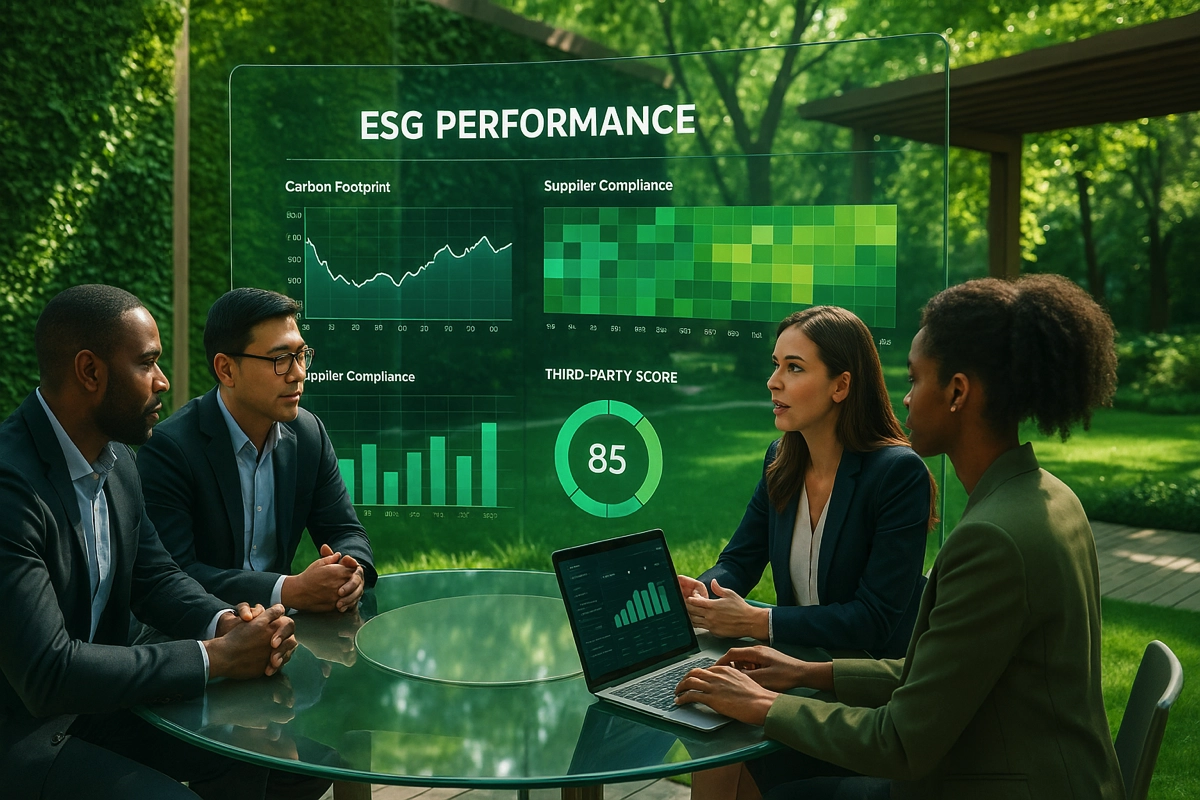TPRM Platform: Essential Features for Modern Third-Party Risk Management

As third-party risk management becomes a strategic priority, TPRM platforms (Third Party Risk Management) are emerging as a must-have standard. This shift responds to a dual imperative: ensuring operational continuity and meeting increasingly complex multi-country regulatory compliance. With over 430,000 third-party vendors assessed across Europe, Aprovall’s experience has helped define the essential features of a modern TPRM platform—now evolving into a broader TPGRC (Third Party Governance & Risk Compliance) approach.
Third-Party Risk Assessment and Management
The core of an effective TPRM strategy lies in structured risk evaluation and monitoring. A robust TPRM platform must enable continuous risk assessment of external partners.
Key pillars include:
Initial and Ongoing Assessments
- Tailored questionnaires based on relationship criticality and risk mapping
- AI-powered automated document collection and analysis
- Multi-dimensional evaluation: cybersecurity, data protection, business ethics, environmental compliance
- A risk-based approach using objective scoring criteria
Smart Automation
- Automated data collection and analysis
- Reduced administrative burden for partners (avoiding supplier fatigue)
- Fast identification of risk profile changes
In the public sector, especially after EU Regulation 2022/576, third-party assessment has become a regulatory cornerstone. Platforms must classify risks by criticality, using a shared knowledge base to streamline decisions.
Due Diligence and Reasonable Vigilance
Collaborative due diligence is key to effective third-party governance. According to recent studies, 57% of organizations plan to intensify third-party evaluation in the next two years. This trend reflects the growing complexity of compliance landscapes.
The most effective TPRM platforms offer multi-tiered risk analysis:
- Basic verification
- Enhanced due diligence
- Deep audits for critical partners (site visits, in-depth interviews)
Automation is crucial—especially when 60%+ of companies manage over 1,000 vendors, often internationally. Reducing administrative load while securing trustworthy data is essential. et Due Diligence
Continuous Monitoring
Beyond onboarding, a TPRM platform must ensure real-time monitoring of potential risk events. According to Gartner, 76% of major third-party incidents in 2024 could have been anticipated through proactive alerts.
Features to include:
- Certification and compliance tracking
- Financial and operational performance monitoring
- Cybersecurity incident detection
- Structural change monitoring (M&A, leadership changes)
To ensure data freshness, the platform should allow third parties to proactively update their profiles, free of charge.
Want to assess the maturity of your third-party risk program?
Regulatory Compliance
Compliance is now a strategic imperative. According to PwC, 78% of organizations view regulatory compliance as key to digital transformation.
Must-have capabilities:
- Automated certification tracking
- Real-time monitoring of regulatory changes
- Sector-specific evaluation workflows
- Customizable compliance dashboards
An efficient platform supports cross-regulatory governance across frameworks like DORA, NIS 2, GDPR, helping reduce non-compliance costs by an average of 20%.
Internal Integration
A best-in-class TPRM solution must integrate seamlessly with:
- Risk management tools
- ERP and SRM platforms
- Compliance systems
This ensures workflow harmonization and cross-functional alignment, such as IT and Legal teams collaborating on security risk management.
Process Automation and Simplification
Simplifying and automating workflows is a core TPRM value. Essential capabilities:
- Smart workflows adapted to risk profiles
- Automated document and certification collection
- Real-time alerts and deadlines
- Collaborative validation
According to Gartner, TPRM automation reduces admin time by 45%, freeing resources for higher-value risk analysis tasks.
Purpose-Built Tools
Risk teams need intuitive tools that combine analysis and actionable insights. A modern platform should include:
- In-depth analytics reports
- Interactive dashboards
- Real-time alerting
- Standardized contract clause templates
These features ensure that companies have all the necessary resources to handle contingencies and maintain proactive risk management.
Cybersecurity Focus
Cyber risk is now central to third-party governance. According to Gartner’s 2024 Third-Party Risk Report, 82% of major cyber incidents involve external vendors.
A TPRM platform should provide:
- Security certification monitoring
- Known vulnerability scanning
- Security policy audits
- Business continuity plan verification
IBM’s 2024 report estimates the average cost of a third-party breach at €4.33M, highlighting the importance of continuous evaluation.
TPRM Implementation: A Strategic Project
Implementing a TPRM platform requires methodical planning. Deloitte found that 73% of successful digital transformations begin with detailed evaluation.
Recommended steps:
- Define objectives and initial scope
- Map existing processes
- Identify critical third parties
- Train teams and promote best practices
Gartner suggests starting with the 20% most critical vendors, which typically represent 80% of total risk.
Ready to transform your third-party risk strategy?
Benefits of Centralized TPRM Platforms
A centralized platform enhances:
- Visibility across third-party relationships
- Cross-department collaboration
- Contract and documentation management
- Responsiveness to emerging risks
It supports stronger governance and helps reduce risks across all tiers of your supplier ecosystem.
Aprovall supports organizations at all maturity levels, with sector-tailored solutions addressing key concerns from cyber risk to ESG alignment and supplier failure mitigation.
These articles might interest you
-
 25 June 2025Manage Your Supplier Assessments by Context and Project for a 360° ViewSolutionsUnlock the Power of Context-Based Evaluations: Gain Clarity and Impact Supplier assessments are often structured as a top-down relationship: from the client (or buyer) to a panel of suppliers. However, these suppliers frequently operate within shared contexts — whether that’s a product, a contract, or an entire supply chain. Managing third-party evaluations by context gives […]
25 June 2025Manage Your Supplier Assessments by Context and Project for a 360° ViewSolutionsUnlock the Power of Context-Based Evaluations: Gain Clarity and Impact Supplier assessments are often structured as a top-down relationship: from the client (or buyer) to a panel of suppliers. However, these suppliers frequently operate within shared contexts — whether that’s a product, a contract, or an entire supply chain. Managing third-party evaluations by context gives […]Read more
-
 11 June 2025Third Parties: Why You Can No Longer Ignore Risk ConvergenceSolutionsWhen it comes to supplier management, focusing on a single risk often means exposing yourself to many others. For a long time, companies have concentrated on financial risks: solvency, credit ratings, payment delays… But recent crises have proven that supplier risks are multiple, systemic, and deeply interconnected. A supplier may be financially sound… yet vulnerable […]
11 June 2025Third Parties: Why You Can No Longer Ignore Risk ConvergenceSolutionsWhen it comes to supplier management, focusing on a single risk often means exposing yourself to many others. For a long time, companies have concentrated on financial risks: solvency, credit ratings, payment delays… But recent crises have proven that supplier risks are multiple, systemic, and deeply interconnected. A supplier may be financially sound… yet vulnerable […]Read more
-
 18 April 2025ESG Strategy for the Supply Chain: Assessment and Management MethodsSolutionsThe ESG strategy (Environment, Social, Governance) has become a fundamental pillar of corporate operational resilience. According to the 2025 Supply Chain ESG Risk Outlook by LRQA, over half of sourcing countries are now classified as high or extreme ESG risk, challenging the common perception that Western markets are inherently safer. This new reality demands a […]
18 April 2025ESG Strategy for the Supply Chain: Assessment and Management MethodsSolutionsThe ESG strategy (Environment, Social, Governance) has become a fundamental pillar of corporate operational resilience. According to the 2025 Supply Chain ESG Risk Outlook by LRQA, over half of sourcing countries are now classified as high or extreme ESG risk, challenging the common perception that Western markets are inherently safer. This new reality demands a […]Read more
-
 24 February 2025Third-Party Risk Dashboard: Optimizing Management and MonitoringSolutionsIn a context where supply chains and external partnerships are becoming increasingly complex, third-party governancehas emerged as a strategic priority for companies. According to a recent study, the global third-party risk management market is expected to reach USD 18.7 billion by 2030, driven by growing regulatory demands and increased reliance on external suppliers. A third-party risk dashboard is a central […]
24 February 2025Third-Party Risk Dashboard: Optimizing Management and MonitoringSolutionsIn a context where supply chains and external partnerships are becoming increasingly complex, third-party governancehas emerged as a strategic priority for companies. According to a recent study, the global third-party risk management market is expected to reach USD 18.7 billion by 2030, driven by growing regulatory demands and increased reliance on external suppliers. A third-party risk dashboard is a central […]Read more
